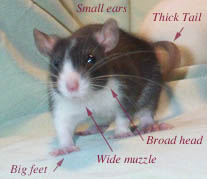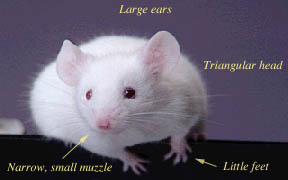
Someone asked me if the rat and mouse are the same, since basically my mother tongue refers these two as 'tikus'.
"Mouse and rat, rat and mouse, they are just the same arent' they?", is what he said after reading my previous post.
but i replied "no".
What do the terms rat and mouse mean?
Rat and mouse are actually not scientific classifications. These words are common names for rodents that look alike to the casual eye.
Rat is used to describe medium-sized rodents with long
 thin tails. There are many species of rodent that are called rats -- kangaroo rats, cotton rats, Norway rats, black rats,etc, and these different rodent species may not be closely related to each other at all!
thin tails. There are many species of rodent that are called rats -- kangaroo rats, cotton rats, Norway rats, black rats,etc, and these different rodent species may not be closely related to each other at all!Mouse is used to describe tiny, sparrow-sized rodents with long thin tails. As with rats, there are many species of rodents called mice which may or may not be closely related to each other.
So, which rats and mice are you talking about?
Commonly, people are referring to the domestic or pest rats and mice, which means :

- Norway rats (Rattus norvegicus),
- black rats (Rattus rattus),
- house mice (Mus musculus).
Theoritically speaking, rats and mice are different in a numbers of terms, such as genetic,anatomy, growth morpholigical,etc.
- Genetic
- Rats have 22 chromosome pairs, mice have 20 (et Levan 1991).
- Rats have 2.75 million base pairs while mice have 2.6 million (humans have 2.9).
- About 90% of rat genes have counterparts in the mouse and human genomes (Rat Genome Sequencing Consortium 2004).
- Growth
- In general, rats develop more slowly than mice.
- For example, Norway rat gestation is slightly longer (21-24 days) than house mouse gestation (19-20 days).
- Norway rats lactate for about 3 weeks, house mice for 2 weeks.
- Both species are born naked and blind, but Norway rats open their eyes at 6th days, they are fully furred at 15 days. House mice open their eyes at 3rd days, have fur at 10 days.
- Anatomy
- Rats have 6 pairs of nipples, mice have 5 pairs.
- Rats have 6 pairs of nipples, mice have 5 pairs.
- Morphological
- Rats are larger, heavier and longer than house mice
- Norway rat: 350-650 grams, 9-11 inch bodies and 7-9 inch tails
- House mice: 30-90 grams, 3-4 inch bodies and 3-4 inch tails
- The heads of rats are heavy, blunt and chunky, while mouse heads are small and sharply triangular with pointed muzzles.
- Others

Due to their larger body size, rat feces are larger than mouse feces
I used to ask myself, "if the rat is still young, how could we differentiate it from adult mice which is about the same size?"
Well, the answer I got is;
Young, weaned rats are still larger than adult mice, weighing around 100 grams at six weeks. However, to the casual observer, very young rats and adult mice can be difficult to tell apart.
Feature | Baby Rat | Adult Mouse |
| Head | short, stubby, broad, large relative to body | small, triangular, small relative to body |
| Muzzle | large and blunt with wide muzzle | narrow with sharp muzzle |
| Ears | ears are small relative to the head | ears are large relative to the head |
| Tail | thick | thin |
| Tail/body ratio | Tail shorter than body | Tail same length/longer than body |
| Feet | Large relative to body, especially the hind feet | Small relative to body |
| Weight | around 100 grams at 6 weeks, 200 grams at 8 weeks | 30-50 grams |
| | 6 week old rat |
Adult mouse |
Referrences:
http://www.ratbehavior.org/RatsMice.htm
http://www.pestakill.co.uk/pest_information/pests.htm














